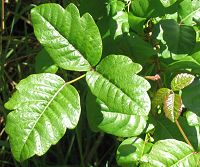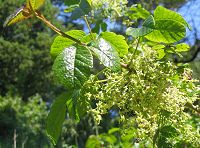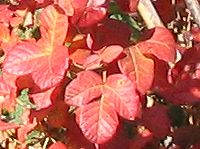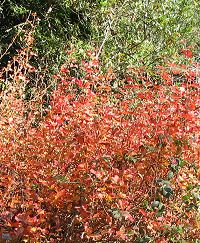
Poison oak is a very common native plant in the East Bay and is found as a ground cover, as a shrub, or as a vine that often entwines around adjacent harmless plants. Most people will develop a rash within a few hours, days, or weeks if they come into contact with any part (leaves, stems, or roots) of this plant. The rash and associated itching will usually last for about 10 days. Most exposures occur by direct contact with the plant. Other sources of exposure are people's or pets' bodies, clothing, and smoke and vapors.

poison oak leaflets in the spring |

poison oak leaflets with flowers in the spring |

poison oak leaflets in the fall and late summer |

poison oak shrub in the fall |
In open areas under full sunlight, poison oak forms a dense leafy shrub usually 1 to 6 feet in height. In shaded areas, such as in coastal redwoods and oak woodlands, it becomes a much taller climbing vine, supporting itself on other vegetation or upright objects by means of aerial roots.
"Leaflets three, let it be" is a safe policy; leaves normally consist of three leaflets with the stalk of the central leaflet being longer than those of the other two; however, occasionally leaves are composed of five, seven, or nine leaflets. (Leaves of true oaks grow singly, not in groups.) Poison oak leaves are alternate on the stem. Each leaflet is 1 to 4 inches long and smooth with toothed or somewhat lobed edges. The surface of the leaves can be glossy or dull, sometimes even somewhat hairy, especially on the lower surface. In spring, poison oak produces small, white-green flowers at the point where leaves attach to the stem. Whitish-green, round fruit form in late summer. In early spring the young leaves are green or sometimes light red. In late spring and summer the foliage is glossy green, and later in the season some or all leaves will be orange or red.
If you are exposed to poison oak, the best way to prevent skin irritation (according to the University of California, Davis) is to pour a mild solvent like rubbing alcohol over the exposed skin followed by lots of cold water (warm water enhances penetration of the oil) within a few minutes of exposure. If rubbing alcohol is not available, just wash with lots of cold water. You need to wash within 5 minutes of exposure to prevent a rash. Even if it is too late to prevent the rash, washing the skin to remove excess plant oil will keep the rash from spreading. The poison oak toxin is an oil, so it does not dissolve in water, but using lots of water will dilute the oil.
Using only a small amount of water or disposable hand wipes is more likely to spread the toxin than remove it. Soaps can be used to wash, but only if used with lots of water; otherwise, they too will spread the toxin.
If a rash develops, you can consider using commercial over-the-counter products to relieve the itching. Available products include calamine lotion, Tecnu®, and ZanfelTM. Read instructions and warnings carefully before applying. Note: The East Bay Regional Park District and Volunteer Trail Safety Patrol do not recommend these products or express an opinion on whether they may be safe or effective for you for this or any use.
If your discomfort is severe, consult your doctor.
This Web site is the property and responsibility of members of the Volunteer Trail Safety Patrol. This Web site is not officially supported by the East Bay Regional Park District.